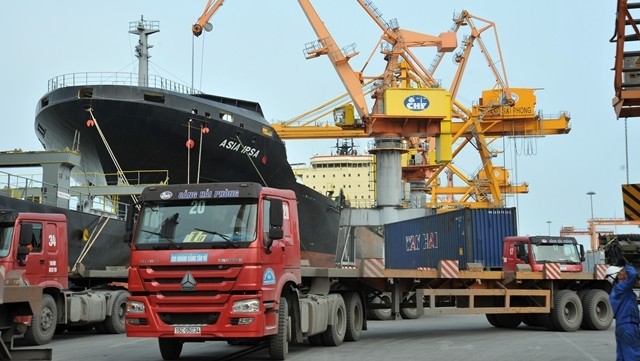At a MOIT regular press conference on Friday morning, Deputy Minister of Industry and Trade Do Thang Hai gave a forecast that exports in the last six months of 2017 would increase for some industrial goods with large export turnover that would enter their growth cycles, such as textiles, footwear and furniture.
He also said that imports of machinery and equipment, which have increased significantly in the first months of the year due to disbursement of a range of projects, should gradual reduce in the last months of 2017.
Export turnover in 2017 is estimated at about US$200 billion, an increase of over 13% against 2016, exceeding the set target. Imports were predicted at US$205 billion, an increase of over 17% over 2016, resulting in a trade deficit for the whole year of about US$5 billion, equalling only 2.5% of export turnover.
Domestic trade is expected to continue its upward trend, especially at the end of the year with high consumer demand; total retail sales and services in 2017 expected at over VND3.8 quadrillion, up more than 10% compared to 2016.
Regarding results in the first half of 2017, MOIT said that industrial production index during the first six months continued its upward trend with an increase of 6.2%. However, this is still lower than the increase in the same period in 2016, as the mining sector was down and the electricity sector recorded low increases.
According to Deputy Minister Hai, export turnover in the January-June period reached US$97.7 billion, up 18.8% and was the highest increase over the same period last year, due to high prices, mainly in the group of fuel and agricultural products, and increased volume, mainly in manufacturing and processing industries.
The highlights were the high growth rates of vegetables and fruits (recording increases of 43.5%) and fishery (up 16.7%), with US$1 billion higher than the turnover in the same period of 2016. Rice, a key export item has recorded an upward trend again thanks to a surge in traditional markets such as Malaysia, Bangladesh and China after a long period of hardship.
Contributing to the success of agro-forestry-fishery product growth were activities on export market development, especially efforts from Vietnam’s high-level diplomatic delegations. For example, Vietnamese fruits have penetrated into many markets with high quality requirements, such as the US has allowed the import of Vietnamese dragon fruit, rambutan, longan and litchi; Japan, the Republic of Korea and New Zealand also open their markets to Vietnam’s dragon fruit and mango; while Australia has licenced the import of Vietnamese litchi and mango.
However, in the first six months of the year, Vietnam also witnessed an increase in imports of fruits due to Vietnam's fruits suffering from climate change impacts and tariff reductions from free trade agreements, as well as simplified procedures, leading to a reduce in the prices of imported fruits.
For the second half of the year, the MOIT will focus on removing difficulties for domestic production and for projects producing export products, creating sources for exports to achieve targets on import and export for the whole year.
Together with that, the ministry will also enhance market information and tackle obstacles to market barriers. In particular, the MOIT will organise the dissemination of free trade agreements to the business community, as well as supporting enterprises to respond to trade remedies.
Deputy Minister Hai stressed that his ministry would implement measures to support enterprises to meet the barriers of quality standards in importing countries and raise the value of export products, particularly agro, forestry and fishery products. On the other hand, the ministry is also focusing on removing barriers and creating conditions for export products, especially agricultural products and seafood penetrating into new markets.
Notably, in the last months of the year, the MOIT will strengthen management of imports and exports through application of trade remedies for imported goods with high volume in accordance with current laws and international commitments.
In addition, the ministry will continue to submit proposals in July to deal with 12 sluggish and ineffective projects. Even with projects whose remedial approaches are still underdeveloped, the ministry will not rule out a plan for bankruptcy. However, the final decision is still awaiting approval from the Government.
















